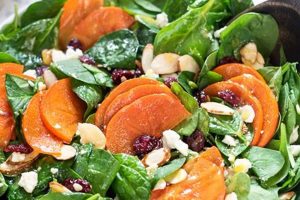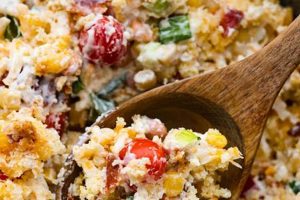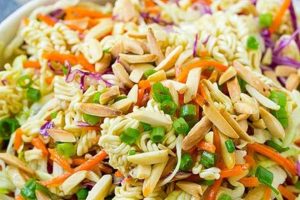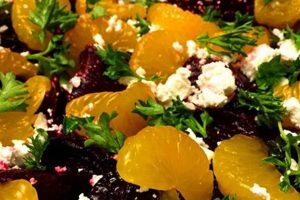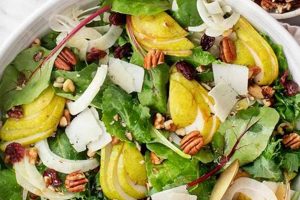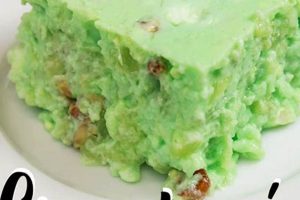A dish featuring flaked, cooked salmon combined with various ingredients to create a flavorful and often chilled salad. Common additions include mayonnaise, celery, onion, dill, and lemon juice. Variations can incorporate other vegetables, herbs, spices, and even fruits like grapes or apples. This preparation offers a versatile meal option, suitable for sandwiches, salads, or served as a standalone dish.
Salmon salad provides a good source of protein and omega-3 fatty acids, beneficial for heart and brain health. Its adaptability allows for customization to individual dietary preferences and ingredient availability. Historically, fish salads have been a practical way to utilize leftover cooked fish, and this tradition continues with contemporary salmon salad recipes, offering a delicious and efficient way to reduce food waste and enjoy the nutritional benefits of salmon.
This discussion will delve into specific ingredient combinations, preparation techniques, and serving suggestions, offering both classic and innovative approaches to creating this culinary staple.
Tips for Exquisite Salmon Salad
Optimizing salmon salad preparation ensures a delightful culinary experience. Careful attention to ingredient selection and technique elevates this dish from simple to exceptional.
Tip 1: Salmon Selection and Preparation: Starting with high-quality, fresh salmon is paramount. Proper cooking ensures optimal flavor and texture. Baking, poaching, or grilling are recommended methods. Avoid overcooking, as this results in dry, less flavorful salad.
Tip 2: Flaking Technique: Once cooked and cooled, flake the salmon gently using a fork. Avoid overly aggressive flaking, which can create a mushy texture. Aim for distinct, yet tender pieces.
Tip 3: Balancing Flavors: Mayonnaise serves as the base, but its richness should be balanced with acidity and freshness. Lemon juice, vinegar, or a combination provide brightness. Fresh herbs, such as dill, parsley, or chives, add depth and complexity.
Tip 4: Textural Variety: Incorporating finely diced celery and red onion offers a satisfying crunch. Other vegetables, like bell peppers or cucumbers, can be added based on preference.
Tip 5: Seasoning Considerations: Salt and freshly ground black pepper are essential. A touch of Dijon mustard or capers can enhance the savory notes. Experiment with spices like smoked paprika or cayenne pepper for added depth.
Tip 6: Chilling and Serving: Allowing the salad to chill for at least 30 minutes allows the flavors to meld. Serve chilled on bread, crackers, lettuce cups, or as a standalone dish. Garnishing with fresh herbs or a lemon wedge enhances presentation and flavor.
Tip 7: Storage: Store leftover salmon salad in an airtight container in the refrigerator for up to three days. Consume within this timeframe for optimal quality and food safety.
By adhering to these guidelines, one can consistently create a salmon salad that is both flavorful and visually appealing, maximizing enjoyment and nutritional value.
This detailed exploration of salmon salad preparation techniques provides a foundation for creating a dish that is both satisfying and nutritious. The following section will offer concluding remarks and further inspiration.
1. Fresh, High-Quality Salmon
The foundation of exceptional salmon salad rests upon the selection of fresh, high-quality salmon. This ingredient dictates the overall flavor, texture, and nutritional value of the final dish. Understanding the characteristics of superior salmon is crucial for achieving optimal results.
- Sourcing and Sustainability:
Responsibly sourced salmon, whether wild-caught or farm-raised, contributes to both environmental well-being and superior flavor. Wild-caught salmon from well-managed fisheries often exhibit a more robust flavor profile, while sustainably farmed salmon offers a consistent and readily available option. Choosing salmon with certifications from reputable organizations ensures adherence to responsible practices.
- Visual Indicators of Freshness:
Fresh salmon displays vibrant color, ranging from deep pink to rich red, depending on the species. The flesh should appear firm and moist, with a glistening surface. Avoid salmon with dull color, dry patches, or a strong, fishy odor. These indicators suggest suboptimal quality and potential spoilage.
- Flavor and Texture Considerations:
High-quality salmon possesses a delicate, yet distinct flavor profile. The texture should be firm and flaky when cooked, without being dry or mushy. The choice between wild-caught and farmed salmon impacts flavor and texture, with wild-caught often exhibiting a richer, more pronounced flavor.
- Nutritional Value and Health Benefits:
Fresh, high-quality salmon provides a rich source of protein and omega-3 fatty acids, essential for heart and brain health. These nutritional benefits contribute significantly to the overall healthfulness of the salmon salad, making it a nutritious and satisfying meal option.
Selecting fresh, high-quality salmon significantly impacts the final outcome of the salmon salad. By prioritizing sourcing, visual indicators, flavor, texture, and nutritional value, one ensures a dish that is not only delicious but also contributes to overall well-being. This emphasis on quality ingredients elevates the salmon salad from a simple dish to a culinary experience.
2. Proper Cooking Methods
Proper cooking methods are essential for achieving a delicious and texturally pleasing salmon salad. The cooking process directly impacts the final flavor, moisture content, and flaking characteristics of the salmon. Overcooking results in dry, tough salmon that is difficult to flake and lacks the delicate flavor desired in a salad. Undercooking, on the other hand, presents food safety concerns and yields a less palatable texture. Choosing an appropriate cooking method and monitoring the salmon’s internal temperature ensures optimal results.
Several methods prove suitable for cooking salmon destined for salad: poaching, baking, and grilling. Poaching in gently simmering liquid produces moist, tender salmon, ideal for flaking. Baking in the oven offers a convenient and consistent approach, resulting in evenly cooked fillets. Grilling imparts a smoky char and enhances the natural flavors of the salmon, adding a unique dimension to the salad. For example, poaching salmon in a court bouillon infused with herbs and lemon creates a subtly flavored, moist fish that flakes beautifully. Alternatively, baking salmon with a light olive oil and herb coating yields a flavorful and tender result. Regardless of the method chosen, monitoring the internal temperature with a food thermometer ensures the salmon reaches the recommended 145F (63C) for optimal safety and texture.
The impact of proper cooking extends beyond flavor and texture. Correctly cooked salmon contributes to the overall aesthetic appeal of the salad, with distinct, appealing flakes rather than a mushy consistency. Furthermore, it ensures food safety by eliminating potential health risks associated with undercooked fish. Mastering the appropriate cooking technique forms a cornerstone of creating a successful and enjoyable salmon salad, enhancing both its culinary and nutritional value.
3. Gentle Flaking Technique
Gentle flaking plays a crucial role in achieving the desired texture and overall quality in salmon salad. Aggressive flaking, often employed for efficiency, results in shredded, mushy salmon, detracting from the final presentation and mouthfeel. A gentler approach preserves the integrity of the salmon, yielding distinct flakes that contribute to a more appealing and palatable salad. This technique enhances the visual appeal of the salad, allowing individual flakes to absorb the dressing and seasonings evenly, resulting in a more flavorful and enjoyable experience. For instance, consider the difference between a salad composed of delicate flakes, each coated in a creamy dill dressing, and a salad with shredded, indistinct pieces of salmon, where the dressing pools unevenly.
The practical significance of this technique extends beyond aesthetics. Gently flaked salmon maintains a lighter, more delicate texture, contrasting pleasantly with the other ingredients in the salad. This textural contrast contributes to a more satisfying sensory experience. Conversely, over-flaked salmon creates a dense, heavy texture, diminishing the overall enjoyment of the dish. Furthermore, gentle flaking allows for better integration of the salmon with the other components of the salad, promoting a harmonious blend of flavors and textures. This careful approach elevates the salmon salad from a simple mixture to a carefully crafted culinary creation.
Proper flaking technique, therefore, constitutes a fundamental step in preparing high-quality salmon salad. This seemingly minor detail significantly impacts the final dish’s texture, flavor, and overall presentation. Attention to this detail distinguishes a thoughtfully prepared salmon salad from a hastily assembled one. Mastering this technique ensures a more enjoyable and aesthetically pleasing culinary outcome.
4. Balanced Flavor Profile
A balanced flavor profile is paramount in crafting exceptional salmon salad. The richness inherent in salmon, particularly when combined with mayonnaise, necessitates careful balancing with contrasting flavors. Acidity, derived from ingredients like lemon juice, vinegar, or capers, cuts through the richness, preventing the salad from becoming overly heavy or cloying. Fresh herbs, such as dill, parsley, or chives, introduce brightness and complexity, complementing the salmon’s natural flavor. The interplay of these contrasting elements creates a harmonious taste experience, where no single flavor dominates. Consider a salmon salad where the richness of the fish and mayonnaise is balanced by the bright acidity of lemon juice and the herbaceous notes of fresh dill. This balance prevents the richness from becoming overwhelming, allowing the nuanced flavors of each ingredient to shine.
The practical significance of this balance extends beyond mere enjoyment. A well-balanced flavor profile enhances the overall sensory experience, making the salad more palatable and appealing. The interplay of contrasting tastes stimulates the palate, creating a dynamic and engaging culinary experience. Furthermore, a balanced flavor profile contributes to the perceived freshness of the salad. The brightness from acidic elements and fresh herbs enlivens the dish, preventing it from tasting heavy or dull. For instance, a salmon salad made with preserved lemons offers a unique depth of flavor, while the addition of chopped shallots provides a pungent counterpoint to the richness of the salmon. Such combinations elevate the salad beyond the ordinary, offering a complex and satisfying flavor journey.
Achieving a balanced flavor profile, therefore, represents a crucial aspect of crafting superior salmon salad. It is not merely a matter of combining ingredients but of orchestrating a symphony of flavors that complement and enhance one another. This careful consideration of flavor balance elevates the dish from simple sustenance to a culinary delight, demonstrating a thoughtful approach to ingredient selection and preparation. This principle of balance underpins the creation of truly exceptional salmon salad, showcasing the transformative power of thoughtful flavor combinations.
5. Textural Considerations
Textural considerations significantly impact the palatability and overall enjoyment of salmon salad. The inherent softness of flaked salmon benefits from the incorporation of ingredients that provide contrasting textures. This interplay of textures creates a more dynamic and satisfying sensory experience. Crunchy elements, such as finely diced celery, red onion, or chopped water chestnuts, offer a counterpoint to the salmon’s tenderness. These textural variations prevent the salad from becoming monotonous, stimulating the palate and enhancing enjoyment. For example, the addition of toasted slivered almonds introduces a welcome crunch and nuttiness, complementing the creamy texture of the salmon and dressing.
The practical significance of textural variation extends beyond mere enjoyment. A variety of textures contributes to a more perceived freshness and lightness. The crispness of vegetables, for example, can balance the richness of the mayonnaise-based dressing, creating a more refreshing and less heavy dish. Furthermore, textural contrast enhances the visual appeal of the salad. The interplay of colors and shapes, coupled with the variety of textures, makes the salad more visually appealing and appetizing. Consider a salmon salad with vibrant green celery, deep red onion, and pale pink salmon flakesthis visual contrast enhances the dining experience. The inclusion of ingredients like capers, with their briny burst, or chopped fresh dill, with its soft, feathery texture, further adds to the complexity of the experience.
Careful consideration of texture, therefore, constitutes an essential element in crafting exceptional salmon salad. This attention to detail elevates the dish beyond a simple combination of ingredients, transforming it into a multi-sensory culinary experience. The strategic incorporation of contrasting textures contributes significantly to the overall enjoyment and satisfaction derived from this versatile dish, showcasing the transformative power of textural interplay in culinary creations.
6. Appropriate Chilling Time
Appropriate chilling time plays a crucial role in the final quality and flavor development of salmon salad. Chilling allows the flavors of the various ingredientssalmon, vegetables, herbs, and dressingto meld and harmonize. This process of flavor integration enhances the overall taste experience, creating a more cohesive and nuanced flavor profile. The cool temperature also firms the texture of the salmon and other ingredients, improving the salad’s overall structure and mouthfeel. For instance, a freshly made salmon salad may taste disjointed, with the individual flavors of the ingredients remaining distinct. However, after an adequate chilling period, typically at least 30 minutes, these flavors merge, creating a more complex and balanced taste. Furthermore, chilling solidifies the fats in the mayonnaise-based dressing, contributing to a creamier, more cohesive texture.
The practical significance of appropriate chilling time extends beyond flavor development. Chilling enhances food safety by inhibiting bacterial growth, a particularly important consideration with seafood-based dishes. Serving salmon salad chilled also improves its palatability, especially in warmer climates. The cool temperature provides a refreshing contrast, making the salad more enjoyable to consume. Moreover, chilling allows the flavors to deepen and mature, resulting in a more pronounced and satisfying taste experience. Consider the difference between a freshly made salmon salad and one that has been chilled for several hours. The chilled salad will exhibit a more refined flavor profile, with the individual components harmonizing into a cohesive whole.
In conclusion, appropriate chilling time represents an essential step in the preparation of high-quality salmon salad. It is not merely a matter of cooling the dish but a crucial element that contributes significantly to flavor development, food safety, and overall palatability. Neglecting this step can compromise the final quality of the salad, resulting in a less flavorful and potentially less safe dish. Understanding the importance of chilling time, therefore, allows for the creation of salmon salad that is both delicious and safe to consume, maximizing its culinary potential.
Frequently Asked Questions
This section addresses common inquiries regarding the preparation and enjoyment of salmon salad made with fresh salmon.
Question 1: What is the best type of salmon to use for salmon salad?
While various salmon species work well, sockeye, king (chinook), and coho are often favored for their flavor and texture. Atlantic salmon, readily available farmed, also provides a suitable option. Ultimately, the best choice depends on individual preference and availability.
Question 2: Can frozen salmon be used for this recipe?
While fresh salmon is generally preferred for optimal flavor and texture, frozen salmon can be substituted. Ensure the salmon is fully thawed and patted dry before cooking to prevent excess moisture in the final salad.
Question 3: How long can salmon salad be stored in the refrigerator?
Salmon salad should be stored in an airtight container in the refrigerator for no more than three days. Consume within this timeframe for optimal quality and food safety.
Question 4: What are some healthy alternatives to mayonnaise in salmon salad?
Greek yogurt, avocado, or a combination thereof offer healthier alternatives to mayonnaise, reducing overall fat content while maintaining a creamy texture. These substitutes also introduce their unique flavor profiles, adding complexity to the salad.
Question 5: Can other ingredients be added to salmon salad?
Salmon salad is highly adaptable. Ingredients such as chopped apples, grapes, walnuts, or hard-boiled eggs can be incorporated to add flavor and textural variety. Customization based on individual preferences allows for diverse and creative variations.
Question 6: How can one ensure the salmon is cooked properly for salad?
Using a food thermometer is the most reliable method for determining doneness. The internal temperature of the salmon should reach 145F (63C). The salmon should appear opaque and flake easily with a fork.
Addressing these common questions provides a comprehensive understanding of salmon salad preparation. This knowledge empowers individuals to create delicious and safe salmon salad tailored to their preferences.
The following section will provide a concluding overview and suggest further culinary explorations related to salmon dishes.
Conclusion
Preparation of superior salmon salad hinges on a series of deliberate steps, from ingredient selection to chilling time. High-quality, fresh salmon forms the foundation, requiring careful cooking to preserve moisture and flavor. Gentle flaking maintains textural integrity, while a balanced flavor profile, incorporating acidity and fresh herbs, prevents richness from becoming overwhelming. Textural variety, achieved through additions like crisp vegetables, creates a dynamic sensory experience. Finally, adequate chilling allows flavors to meld, maximizing enjoyment and food safety.
Culinary exploration rarely concludes; it evolves. Mastery of salmon salad technique provides a gateway to further experimentation with ingredients, flavors, and presentations. This understanding allows adaptation to individual preferences and dietary needs, ensuring continued enjoyment and appreciation of this versatile dish. The potential for creativity within this seemingly simple preparation remains vast, inviting continued exploration and refinement of culinary skills.

